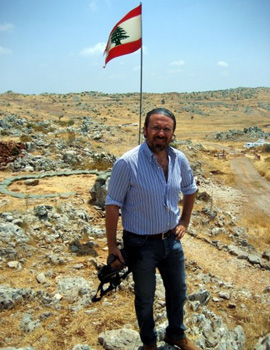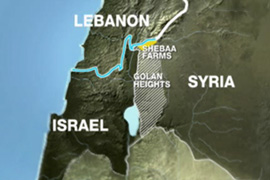Behind the ‘blue line’
Israel withdrew from south Lebanon in May 2000, but the disputed border remains tense.

When Israel withdrew from south Lebanon in May 2000, the UN drew a blue line to divide the two countries. But in drawing this line, it placed a region called the Shebaa Farms – a sliver of land between Lebanon and Syria – outside of Lebanon and within the Syrian Golan Heights, which are currently occupied by Israel.
Lebanon says it owns the Shebaa Farms and Syria agrees. But the UN has ruled that it belongs to Syria and Israel says it will only withdraw from the area via negotiations with Syria.
On the 10th anniversary of the Israeli withdrawal from south Lebanon, award-winning Lebanese filmmaker Abdallah El Binni went behind the ‘blue line’ to see how poorly-defined and disputed international borders are increasing the volatility of this frontline in the Arab-Israeli conflict.
He talks to Al Jazeera’s Fatma Naib about going behind the ‘blue line’.
Al Jazeera: You filmed in the small south Lebanese town of Kfar Shouba which is beside the Shebaa Farms and overlooked by Israeli military positions on the nearby hilltops. What is the mood like there?
 |
| Filmmaker Abdallah El Binni at the border |
Abdallah El Binni: We tried to shed some light on the ongoing border issue and the problems created by the blue line drawn by the UN after Israel withdrew from south Lebanon in 2000.
The hills of the town of Kfar Shouba are still occupied, while the town itself was liberated on May 25, 2000.
We witnessed a lot of tension in the area while filming.
This tension had initially been ignited in July 2009, when Israel built a sand barricade and an observation tower in the no man’s land by the blue line.
Israel placed an Israeli flag on top of this which angered the people of the town because they see this land as Lebanese.
As an act of protest the villagers crossed the virtual blue line. Some of them removed the Israeli flag from the sand barrier and replaced it with the Lebanese flag and that of the Lebanese group Hezbollah.
The Israelis were infuriated by this and Israeli tanks quickly arrived on the scene. The UN peacekeepers (the United Nations Interim Force in Lebanon or UNIFIL) and the Lebanese army went on high alert.
After several international interventions the situation eventually calmed down, but the same scenario was repeated again in May 2010.
But such incidents have the potential to spark hostilities and I believe that as long as the occupation continues similar situations could arise again.
What are relations like between the town’s residents and the UNIFIL forces based in the area?
The historical relationship between the UNIFIL forces and the villagers of the south is now 32 years old, but it needs constant reconfirmation of mutual trust.
With each security incident that mutual trust is potentially brought to the verge of collapse.
The residents of the town try to keep a friendly atmosphere with the UN forces – as long as they are not perceived as acting as Israel’s protectors.
Do you believe that the colonial history of the region is the root cause of some of the problems now being encountered?
| IN DEPTH | |||||||||||||||||||
|
The French and British colonialist regimes in Lebanon, Syria and Palestine left geographical ticking time bombs that will explode at different times.
Lebanon’s international border was drawn up in 1923 by Colonels Paulet and Newcombe – French and British officers at the time of the French Mandate of Lebanon and the British Mandate of Palestine.
The inconsistencies of the colonial cartographers – in defining the borders between Lebanon, Syria and Palestine – created problems for the future.
From 1939, joint Syrian-Lebanese committees were set up to arbitrate land disputes between residents of the Shebaa Farms area.
The first document recognising Lebanese sovereignty over the Shebaa Farms dates back to March 27, 1946.
Over the years joint Syrian-Lebanese committees continued to arbitrate on land disputes among farmers in the area.
But the Six Day War in 1967 changed everything.
In its victory Israel seized, among other land, the Golan Heights and the Shebaa Farms area.
What happened in the region after the Six Day War?
In the late 1960s and 70s the Shebaa Farms region – and the surrounding areas – became a front for the Palestine Liberation Organization (PLO).
After the Arab-Israeli war in October 1973, the UN deployed peacekeeping troops to the Golan Heights.
The occupied Shebaa Farms area came under the operational remit of this UN force – known as UNDOF.
The UN clearly considered the Shebaa Farms to be part of the Syrian Golan Heights.
What challenges did you encounter while filming in the region?
Filming by the border was not allowed. We obtained a filming permit from the Lebanese army which allowed us to film the blue line, but we are not allowed to film the UNIFIL forces or the Israeli army.
Because of my familiarity with the border area, I knew that approaching the border was risky.
In the Kfar Shouba hills, we crossed the border that led to the blue line with some villagers and soldiers from the Lebanese army.
This concerned the UNIFIL forces, who – thinking that we were going to cross the blue line – called for reinforcements to act as a human shield between us and the border.
How important is the Shebaa Farms region to Israel and do you believe Israel will ever willingly withdraw from the area?
 |
The Shebaa Farms are on the outskirts of the Golan Heights, which was occupied by Israel after the Six Day War in 1967.
Israel wants to tie the Shebaa Farms – which it sees as a key strategic area that is critical to its security and an important negotiating card – to the Golan Heights in any future negotiations with Syria.
In my opinion Israel wants to use the Shebaa Farms to pressure Hezbollah to demilitarise it.
Hezbollah emphasises Lebanese sovereignty over the Shebaa Farms and rejects calls for its disarmament, based on the premise that Israel still occupies Lebanese land.
Do you believe that there will be further hostilities along the border?
Syria says that the Shebaa Farms region is Lebanese and according to historical documents it belongs to Lebanon. This means that Israel still occupies Lebanese land and that Lebanon has the right to ensure its return by diplomatic or military means.
We filmed at the exact spot in an area called Berkat al-Naqar where Hezbollah fighters captured three Israeli soldiers in 2000.
This area is very sensitive for the Israelis and it is surrounded by a lot of key strategic military areas.
When the UNIFEL forces saw us approach the border they alerted the Israeli army – who arrived within minutes – and we were asked to leave.
The tensions along the border will continue as long as there is an occupation.
Once the land is returned things may calm down. But based on the experiences of other Arab countries, I think it would be delusional to believe that Israel will just give up the territories.
There will be a price to pay in order for the land to be returned.
The issue of water is key to this dispute because the Shebaa Farms region is seen as Palestine’s water tank – and this is one of the main reasons why Israel is still there.
It will probably be one of the key negotiating cards Israel will use in any future negotiations with Syria.
As long as the Shebaa Farms are occupied, it remains a reason for resistance.
The atmosphere is very tense in the Middle East and everyone talks about a future war between Israel, Hezbollah and Syria.
On the 10th anniversary of the liberation of (most) of southern Lebanon, I do not believe that war will break out in the near future. But I do think that tensions will continue to rise.